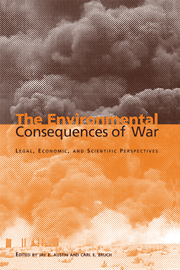Book contents
- Frontmatter
- Contents
- List of illustrations
- List of tables
- List of contributors
- Acknowledgements
- Foreword by Klaus Toepfer
- Introduction
- Part I General principles
- Part II The legal framework
- Part III Assessing the impacts – scientific methods and issues
- Part IV Valuing the impacts – economic methods and issues
- Part V Prospects for the future
- Index
Foreword by Klaus Toepfer
Published online by Cambridge University Press: 04 August 2010
- Frontmatter
- Contents
- List of illustrations
- List of tables
- List of contributors
- Acknowledgements
- Foreword by Klaus Toepfer
- Introduction
- Part I General principles
- Part II The legal framework
- Part III Assessing the impacts – scientific methods and issues
- Part IV Valuing the impacts – economic methods and issues
- Part V Prospects for the future
- Index
Summary
In the last three decades of the twentieth century, the world community started focusing on global environmental challenges and the ways in which such challenges could be effectively addressed. The 1972 United Nations Conference on the Human Environment, which resulted in the establishment of the United Nations Environment Programme, and the 1992 United Nations Conference on Environment and Development were landmarks in setting the global agenda to protect the environment and pursue sustainable development. States and people have joined forces to tackle common environmental challenges such as: global climate change; loss of biological diversity; destruction of the ozone layer; desertification; and transboundary impacts of persistent toxic substances. Further globalization in the new century will accelerate trans-border cooperation in environmental and sustainable development issues, which, in any case, do not respect any boundaries.
These decades also witnessed devastating damage to people and the environment as a result of inter-state wars and armed civil conflicts. Defoliants were used in Southeast Asia as a means of war, causing long-term hazards to human health and the environment. In the Gulf, deliberate oil burning and discharge were used in hostilities, which seriously damaged the marine and coastal environment, caused transboundary air pollution and contaminated soil and groundwater. The human environment, people's livelihoods, was the target of aggression during conflicts in Kosovo. Armed conflicts in Afghanistan and West and Central Africa forced millions of people to become refugees, posing significant stress to the environment. Weapons of mass destruction - nuclear, chemical or biological - could cause devastating environmental consequences and such weapons have continued to be in the arsenals of a number of states.
- Type
- Chapter
- Information
- The Environmental Consequences of WarLegal, Economic, and Scientific Perspectives, pp. xix - xxPublisher: Cambridge University PressPrint publication year: 2000

